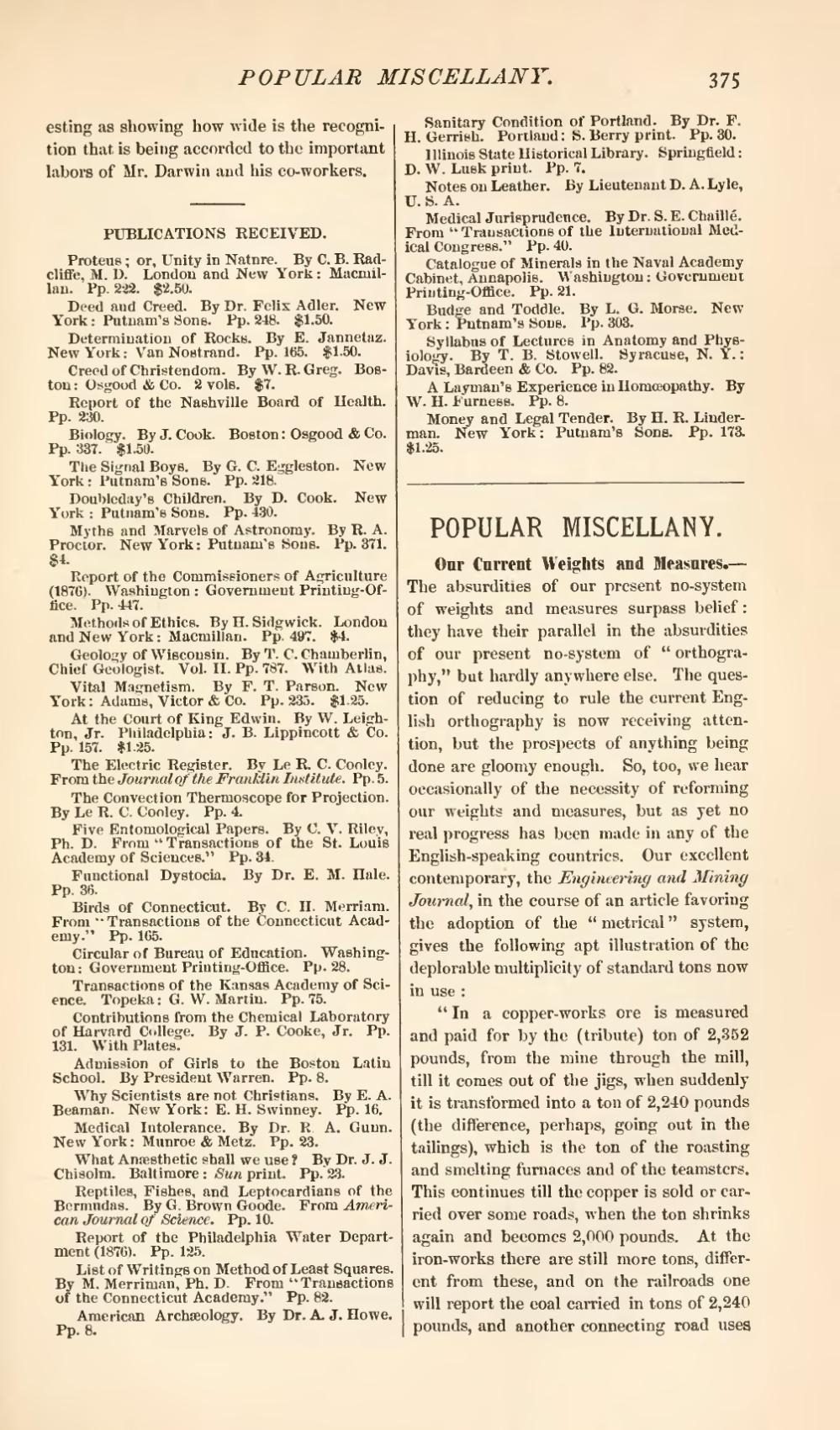esting as showing how wide is the recognition that is being accorded to the important labors of Mr. Darwin and his co-workers.
Proteus; or, Unity in Nature. By C. B. Radcliffe, M.D. London and New York: Macmillan. Pp. 222. $2.50.
Deed and Creed. By Dr. Felix Adler. New York: Putnam's Sons. Pp. 248. $1.50.
Determination of Rocks. By E. Jannetaz. New York: Van Nostrand. Pp. 165. $1.50.
Creed of Christendom. By W. R. Greg. Boston: Osgood & Co. 2 vols. $7.
Report of the Nashville Board of Health. Pp. 230.
Biology. By J. Cook. Boston: Osgood & Co. Pp. 337. $1.50.
The Signal Boys. By G. C. Eggleston. New York: Putnam's Sons. Pp. 218.
Doubleday's Children. By D. Cook. New York: Putnam's Sons. Pp. 430.
Myths and Marvels of Astronomy. By R. A. Proctor. New York: Putnam's Sous. Pp. 371. $4.
Report of the Commissioners of Agriculture (1876). Washington: Government Printing-Office. Pp. 447.
Methods of Ethics. By H. Sidgwick. London and New York: Macmillan. Pp. 497. $4.
Geology of Wisconsin. By T. C. Chamberlin, Chief Geologist. Vol. II. Pp. 787. With Atlas.
Vital Magnetism. By F. T. Parson. New York: Adams, Victor & Co. Pp. 235. $1.25.
At the Court of King Edwin. By W. Leighton, Jr. Philadelphia: J. B. Lippincott & Co. Pp. 157. $1.25.
The Electric Register. By Le R. C. Cooley. From the Journal of the Franklin Institute. Pp. 5.
The Convection Thermoscope for Projection. By Le R. C. Cooley. Pp. 4.
Five Entomological Papers. By O. V. Riley, Ph. D. From "Transactions of the St. Louis Academy of Sciences." Pp. 34.
Functional Dystocia. By Dr. E. M. Hale. Pp. 36.
Birds of Connecticut. By C. H. Merriam. From "Transactions of the Connecticut Academy." Pp. 165.
Circular of Bureau of Education. Washington: Government Printing-Office. Pp. 28.
Transactions of the Kansas Academy of Science. Topeka: G. W. Martin. Pp. 75.
Contributions from the Chemical Laboratory of Harvard College. By J. P. Cooke, Jr. Pp. 131. With Plates.
Admission of Girls to the Boston Latin School. By President Warren. Pp. 8.
Why Scientists are not Christians. By E. A. Beaman. New York: E. H. Swinney. Pp. 16.
Medical Intolerance. By Dr. R. A. Gunn. New York: Munroe & Metz. Pp. 23.
What Anæsthetic shall we use? By Dr. J. J. Chisolm. Baltimore: Sun print. Pp. 23.
Reptiles, Fishes, and Leptocardians of the Bermudas. By G. Brown Goode. From American Journal of Science. Pp. 10.
Report of the Philadelphia Water Department (1876). Pp. 125.
List of Writings on Method of Least Squares. By M. Merriman, Ph. D. From "Transactions of the Connecticut Academy." Pp. 82.
American Archæology. By Dr. A. J. Howe. Pp. 8.
Sanitary Condition of Portland. By Dr. F. H. Gerrish. Portland: S. Berry print. Pp. 30.
Illinois State Historical Library. Springfield: D. W. Lusk print. Pp. 7.
Notes on Leather. By Lieutenant D. A. Lyle, U. S. A.
Medical Jurisprudence. By Dr. S. E. Chaillé. From "Transactions of the International Medical Congress." Pp. 40.
Catalogue of Minerals in the Naval Academy Cabinet, Annapolis. Washington: Government Printing-Office. Pp. 21.
Budge and Toddle. By L. G. Morse. New York: Putnam's Sons. Pp. 303.
Syllabus of Lectures in Anatomy and Physiology. By T. B. Stowell. Syracuse, N. Y.: Davis, Bardeen & Co. Pp. 82.
A Layman's Experience in Homœopathy. By W. H. Purness. Pp. 8.
Money and Legal Tender. By H. R. Linderman. New York: Putnam's Sons. Pp. 173. $1.25.
Our Current Weights and Measures.—The absurdities of our present no-system of weights and measures surpass belief: they have their parallel in the absurdities of our present no-system of "orthography," but hardly anywhere else. The question of reducing to rule the current English orthography is now receiving attention, but the prospects of anything being done are gloomy enough. So, too, we hear occasionally of the necessity of reforming our weights and measures, but as yet no real progress has been made in any of the English-speaking countries. Our excellent contemporary, the Engineering and Mining Journal, in the course of an article favoring the adoption of the "metrical" system, gives the following apt illustration of the deplorable multiplicity of standard tons now in use:
"In a copper-works ore is measured and paid for by the (tribute) ton of 2,352 pounds, from the mine through the mill, till it comes out of the jigs, when suddenly it is transformed into a ton of 2,240 pounds (the difference, perhaps, going out in the tailings), which is the ton of the roasting and smelting furnaces and of the teamsters. This continues till the copper is sold or carried over some roads, when the ton shrinks again and becomes 2,000 pounds. At the iron-works there are still more tons, different from these, and on the railroads one will report the coal carried in tons of 2,240 pounds, and another connecting road uses
